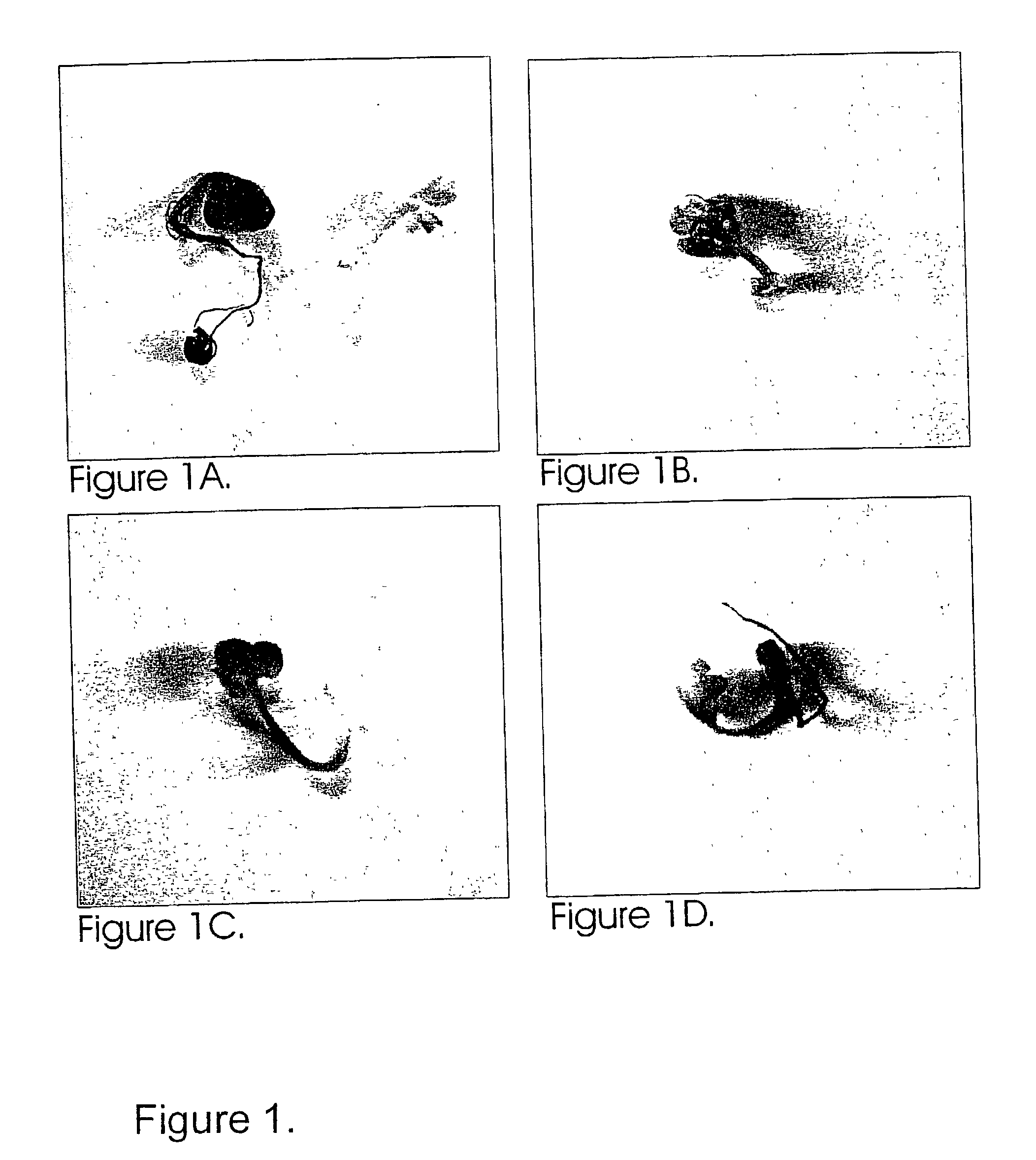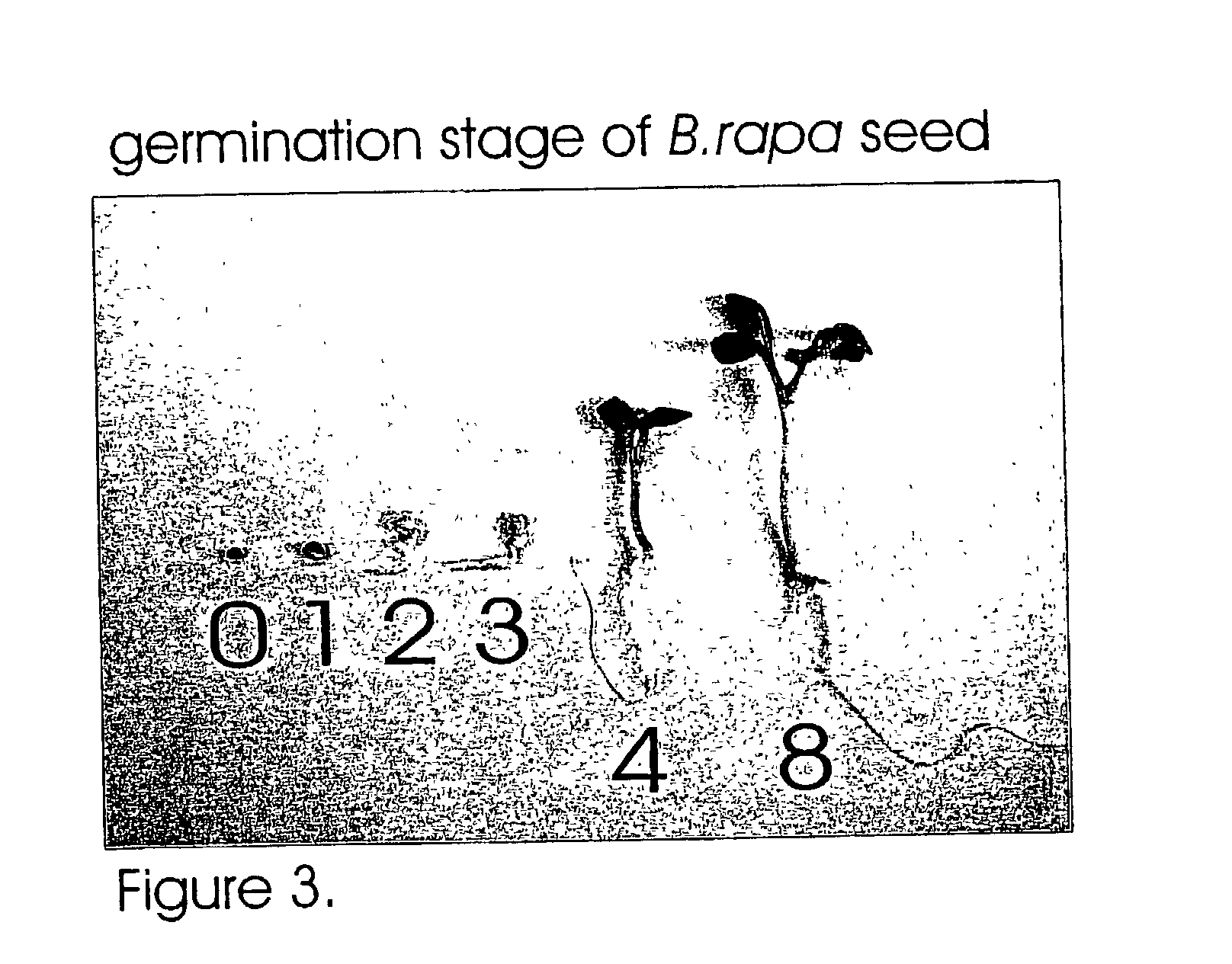Process for converting storage reserves of dicot seeds into compositions comprising one or more gene products
a technology of dicot seeds and gene products, which is applied in the direction of lyse, biochemistry apparatus and processes, fermentation, etc., can solve the problems of small protein content of tobacco leaf, inability to express heterologous proteins, and inability to achieve therapeutic mammalian proteins
- Summary
- Abstract
- Description
- Claims
- Application Information
AI Technical Summary
Benefits of technology
Problems solved by technology
Method used
Image
Examples
example 1
GUS Gene Expression in Germinating Brasssica campestris Seeds
[0100] GUS expression is demonstrated with a histochemical assay. Four different promoters are used to regulate the GUS expression. The promoters used are Soybean heat shock promoter, Vigna mungo endopeptidase promoter, Nicotiana tabacum pr-promoter and CaMV 35S promoter. Promoter sequences are produced by PCR using plant total DNA as a template.
[0101] The promoters were linked to the GUS gene using NcoI enzyme. The promoter-GUS constructs were cloned in a plant transformation vector, pGPTV-hpt (Becker et al. 1992. Plant Mol. Biol. 20:1195-97). B. campestris was transformed according to the protocol described by Kuvshinov, V. et al. (Plant Cell Reports 18:773-777, 1999). The transgenic plants were grown in greenhouse until they produced seeds. The transgenic seeds were germinated and used for the histochemical GUS assay.
[0102] The results are described in the Figures.
[0103] On the left side in FIG. 1A a germinated seed of ...
example 2
The Preparation of Novel RbcS-promoters for the Expression System
[0111] a. Isolation of a Novel RbcS-promoter
[0112] Rbc cDNA-clones were sequenced from four days old transgenic cotyledons of Brassica campestris. The clones were divided into two groups with similar characteristics based on the sequence of 3 'UTR region.
[0113] SDS-page analysis of Brassica campestris seedlings. Seeds of Brassica campestris were germinated in series of 1 to 7 days. Five pairs of cotyledons were ground in liquid nitrogen and resuspended in lysis-loading buffer (50 mM Tris HCl pH 8.5, 2% SDS, 0.1% Bromophenol Blue, 10% glycerol, 2% mercaptoethanol (2-ME). Samples were boiled in a water bath for ten minutes and analysed in 15% SDS-PAGE gel according to the Laemmli (1970). The Rbc gene expression was estimated to initiate 4 days after imbibition.
[0114] b. RNA-purification from Brassica campestris Cotyledons.
[0115] RNA was purified from 4 days old cotyledons by using Qiagen RNeasy Kit.
[0116] c. cDNA-synthes...
example 3
Comparison of Different Constitutive and Inducible Promoters for the Overexpression of Transgene (GUS) in Tobacco and Brassica campestris
[0130] Germinating seedlings were frozen with liquid nitrogen and grinded. Proteins were extracted with phosphate-EDTA buffer. Samples were centrifuged and supernatants were analysed using .beta.-glucuronidase activity detection kit (Sigma). Protein concentration of samples were analysed with Protein assay reagent (Biorad) using BSA as a standard.
5TABLE 3 The specific activities of GUS with different constitutive and inducible promoters in tobacco and Brassica campestris. SPECIFIC ACTIVITY (nmol PLANT PROMOTER MU / min / mg of soluble protein) tobacco B. rubisco type I 7 B. campestris Heat shock 44 B. campestris Heat shock amylase 5 B. campestris 35S 28
[0131] When following the promoter activity in germinating seed during germination in a series of seven days an exponential increase in specific activity for example in rubisco promoter was detected. The...
PUM
| Property | Measurement | Unit |
|---|---|---|
| temperatures | aaaaa | aaaaa |
| temperature | aaaaa | aaaaa |
| temperature | aaaaa | aaaaa |
Abstract
Description
Claims
Application Information
 Login to View More
Login to View More - R&D
- Intellectual Property
- Life Sciences
- Materials
- Tech Scout
- Unparalleled Data Quality
- Higher Quality Content
- 60% Fewer Hallucinations
Browse by: Latest US Patents, China's latest patents, Technical Efficacy Thesaurus, Application Domain, Technology Topic, Popular Technical Reports.
© 2025 PatSnap. All rights reserved.Legal|Privacy policy|Modern Slavery Act Transparency Statement|Sitemap|About US| Contact US: help@patsnap.com



